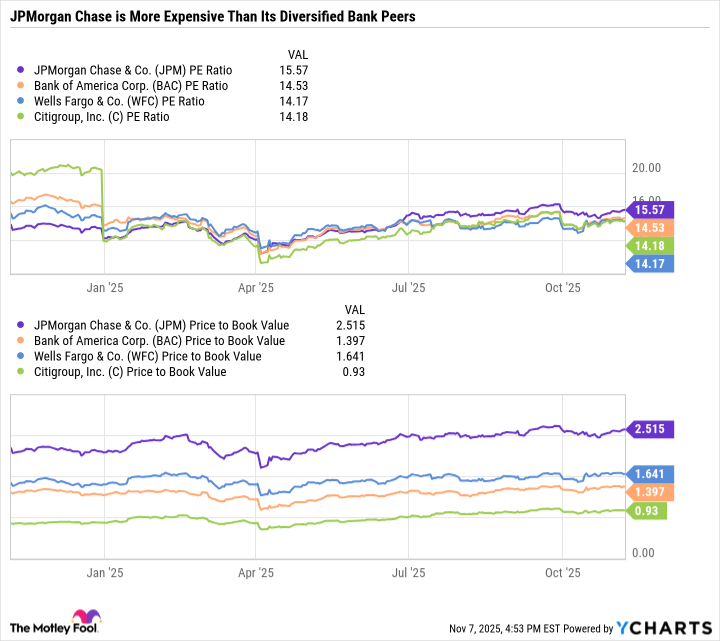Lately, the stock market has been marking many market capitalization milestones. Nvidia surpassed $5 trillion in market cap, and Microsoft and Apple soared above $4 trillion.
At this writing, Alphabet is over $3.3 trillion, Amazon is around $2.6 trillion, and Broadcom, Meta Platforms, and Tesla are all over $1.4 trillion.
But the only nontech-focused U.S. company with a market cap over $1 trillion is Berkshire Hathaway (BRK.A +0.15%) (BRK.B +0.03%).
Here's why JPMorgan Chase (JPM 0.43%) could become the next value stock to join the $1 trillion club, and why the dividend stock is a buy now.

Image source: Getty Images.
Two financial titans
Warren Buffett's Berkshire Hathaway gets a lot of attention for its positions in public equities. But the value of its controlled businesses, led by insurance, as well as its mound of cash, cash equivalents, and Treasury bills, is far more valuable.
Berkshire's strength is its ability to produce growing operating earnings from its controlled businesses, which takes the pressure off the need to buy shares in public companies. In fact, Berkshire has been reducing its stakes in top holdings like Apple and Bank of America (BAC +0.39%) and has gone five consecutive quarters without repurchasing Berkshire Hathaway stock.
JPMorgan is similar to Berkshire in that it is a highly differentiated business that can pull multiple levers to grow earnings. The diversified bank generates revenues from its commercial and investment banking services, as well as net interest income (NII) from interest-earning assets. When interest rates are high, the company can generate more NII, but high rates can also slow deal-making, mergers and acquisitions, and mortgage and car loan activity.
NII is the difference between interest earned on loans and interest paid on deposits. It's similar to an insurance company's float, which is the amount of premiums that haven't been paid out in claims. For decades, Warren Buffett has discussed the importance of growing Berkshire's float. The stockpile is now so large that Berkshire generates billions of income from it each quarter. NII is valuable because it is highly profitable and high margin.
The other side of the business is non-interest revenue, which JPMorgan generates from fees, commissions, investment banking services, and asset management.
As shown in the table, JPMorgan has steadily increased its NII and non-interest revenue (practically uninterrupted) for the last decade.
|
Metric |
2016 |
2017 |
2018 |
2019 |
2020 |
2021 |
2022 |
2023 |
2024 |
2025 (Guidance) |
|---|---|---|---|---|---|---|---|---|---|---|
|
Net interest income (billions) |
$46.08 |
$50.1 |
$55.05 |
$55.06 |
$54.56 |
$52.31 |
$66.71 |
$89.27 |
$92.58 |
$95 |
|
Non-interest revenue (billions) |
$49.59 |
$50.61 |
$53.97 |
$53.72 |
$64.98 |
$69.34 |
$61.99 |
$68.84 |
$84.97 |
N/A |
Data source: JPMorgan Chase.
Over the last three years, results have accelerated in lockstep with JPMorgan's surging stock price -- which has tripled in the last five years. The financial sector has more than doubled over that period, outperforming the S&P 500 (^GSPC +0.21%).

NYSE: JPM
Key Data Points
Elevated valuations
JPMorgan's outsized gains are backed by quarter after quarter of blowout results. In third quarter 2025, JPMorgan earned a whopping 20% return on tangible common equity (ROTCE). ROTCE is a key profitability metric used by big banks to show how effectively they are profiting from their capital. It's similar to how investors compare operating margin as a profitability metric in other industries.
JPMorgan's ROTCE tends to be higher than its peers -- Bank of America, Wells Fargo (WFC +0.10%), and Citigroup (C 0.73%). This is why JPMorgan has a more expensive valuation, based on price-to-earnings (P/E) and price-to-book (P/B) value.
JPM PE Ratio data by YCharts
For context, JPMorgan's 10-year median P/E is 11.9 and its 10-year median P/B is just 1.5. So the bank is relatively expensive right now, but for good reason because its growth rate has accelerated.
Similar to JPMorgan, Walmart's (WMT +1.00%) stock price has skyrocketed in recent years. Both companies now have market caps over $800 billion -- pushing them closer to joining the $1 trillion club.
Like JPMorgan, Walmart's stock price is responding to improving fundamentals in the underlying business. The company has done a masterful job of delivering value to its customers and producing solid results, even as many of its retail and consumer staples peers struggle. In its latest quarter, Walmart grew revenue by 4.8% year over year, but adjusted operating income was up less than 1%.
Walmart is leveraging artificial intelligence (AI) to improve its operations -- announcing a partnership with OpenAI that allows customers to complete purchases from Walmart directly within ChatGPT. Walmart is producing excellent results from its advertising business, as well as e-commerce and delivery through Walmart+. But still, those results aren't good enough to justify its sky-high P/E of 38.7, compared to a 10-year median P/E of 28.4.
A premium-priced stock worth buying now
Buying stocks at all-time highs is never easy. But in today's market, it's hard to find high-quality, industry-leading companies at dirt cheap valuations.
The solution isn't to sell out of an expensive market, but rather to center your portfolio around companies that can consistently grow earnings fast enough to justify their valuations.
JPMorgan stands out as the most likely candidate to join Berkshire Hathaway in the $1 trillion club, simply by continuing to grow its NII over time. Meanwhile, Walmart is already expensive and doesn't have a clear path toward accelerating earnings growth at a rate that would justify its already overextended valuation.
JPMorgan and Walmart pass along a considerable amount of capital to shareholders through buybacks and dividends, but JPMorgan has a higher yield at 1.9% compared to Walmart's 0.9%.
All told, JPMorgan stands out as the type of expensive stock that's worth buying and holding, whereas Walmart isn't growing earnings rapidly enough to justify its nosebleed valuation.
